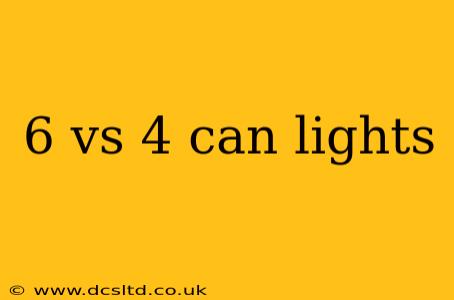6 vs 4 Can Lights: Illuminating the Differences and Choosing the Right Fit
Choosing the right number of can lights for a room can significantly impact its ambiance and functionality. The debate between 6 and 4 can lights often arises, and the best option depends heavily on factors like room size, ceiling height, desired brightness, and the layout of your space. This guide will help you navigate this decision, shedding light on the pros and cons of each.
What factors determine the number of can lights needed?
This is a crucial question, and the answer is multifaceted. Several factors influence the ideal number of recessed lights for any given room. These include:
-
Room Size: Larger rooms naturally require more lighting fixtures to achieve even illumination. A small bathroom might be adequately lit with four can lights, while a spacious living room might benefit from six or even more.
-
Ceiling Height: Higher ceilings necessitate more can lights to prevent dark corners and shadows. The light has to travel further, so more fixtures compensate for the distance.
-
Layout of the Room: The arrangement of furniture and the placement of focal points should guide the placement of can lights. Avoid concentrating lights in one area, and aim for even distribution.
-
Desired Brightness Level: How bright do you want the room to be? For tasks requiring more light, like a kitchen or home office, you might need more can lights than for a bedroom or living room where a softer ambiance is desired.
-
Type of Bulbs: The wattage and type of bulb (e.g., LED, halogen) also play a role in the overall brightness. LEDs, for example, are highly energy-efficient and often brighter than traditional incandescent bulbs.
How many lumens per square foot do I need?
The number of lumens needed per square foot depends largely on the room's function and desired brightness. While there’s no single magic number, a general guideline is to aim for:
- 20-30 lumens per square foot for general ambient lighting. This is sufficient for most living rooms and bedrooms.
- 30-40 lumens per square foot for task lighting areas. This is ideal for kitchens, home offices, or areas requiring more intense illumination.
Remember to account for the lumen output of your chosen bulbs when calculating the total lumens needed for your space. The specifications of your can lights will typically list their maximum wattage.
Is 6 can lights too many for a small room?
While it’s generally true that too many lights can lead to harsh, overly bright illumination, it’s not a hard and fast rule. In a small room, six can lights could be too many if the lights are too powerful or are poorly spaced. Careful planning, including proper placement and the use of lower-wattage bulbs, can mitigate this. However, if the room is unusually long or if it is a space that needs to be bright for tasks, then six can lights may be adequate.
Will 4 can lights be enough for a large room?
For most larger rooms, four can lights will likely be insufficient for even illumination. Four might work for a small or unusually bright area, but for most average-sized rooms, more fixtures will be necessary to prevent dark corners and ensure adequate brightness.
What's the best way to plan the placement of can lights?
Strategic planning is essential for optimal lighting. Here are some tips:
- Create a grid: Divide your room into equal sections and place can lights accordingly.
- Consider focal points: Position lights to highlight specific areas like a fireplace or artwork.
- Avoid direct overhead: Instead of placing all lights in the center, consider a more distributed pattern.
- Use a lighting design software: Various programs can help visualize the light distribution before installation.
Ultimately, the choice between four and six can lights depends on your specific needs and preferences. Careful consideration of the factors discussed above will ensure you make the best choice for your space. If you're unsure, consulting with a lighting professional can provide valuable insight and ensure you create a well-lit and aesthetically pleasing environment.
